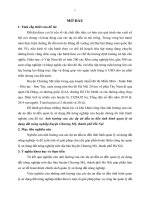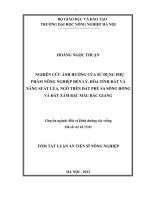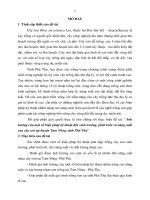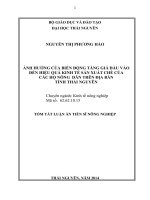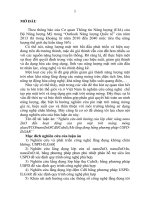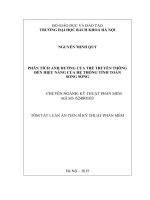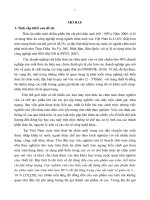03Tóm tắt luận án thanouxay tieng anh
Bạn đang xem bản rút gọn của tài liệu. Xem và tải ngay bản đầy đủ của tài liệu tại đây (1.28 MB, 28 trang )
MINISTRY OF EDUCATION AND TRAINING MINISTRY OF FINANCE
ACADEMY OF FINANCE
THANOUXAY SIVANNALIT
STATE BUDGET EXPENDITURE STRUCTURE PROMOTES
SUSTAINABLE ECONOMIC DEVELOPMENT IN THE LAO
PEOPLE'S DEMOCRATIC REPUBLIC
Major : Finance – Banking
Code : 9.34.02.01
SUMMARY OF DOCTORAL THESIS
HA NOI- 2022
The thesis was completed in Academy of Finance
Supervisors:
1. Assoc. Prof. Dr. Vuong Thi Thu Hien
2. Dr. Dao Thi Bich Hanh
Reviewer
1: ............................................................................................... ............................
....................................................................................................
Reviewer 2: ...............................................................................................
................................................................................................................................
Reviewer 3: ................................................................................................
................................................................................................................................
The thesis will be defensed at the Academy-level doctoral thesis
commitee, in Academy of Finance, at…………., on………………2022.
Can be accessed in:
- The National Library
- The Library of Academy of Finance
INTRODUCTION
1. The necessity of the thesis
In the market economy, state budget expenditure (SBE) is used as an
effective tool to perform the functions and tasks of the State. Through SBE, the
State regulates the macro economy, stimulates production and business
activities, promotes economic growth and ensures social security.
In the Lao People's Democratic Republic (Laos), in recent years, along
with the increasing trend of the SBE scale, the spending structure has also been
adjusted and innovated in order to stimulate economic growth. However, the
global financial and economic crisis in 2008 brought the global financial
economy into a severe and prolonged recession, leading to a decline in the
overall economic growth rate of Laos. The transition to a sustainable and
effective economic market model is an inevitable and objective trend of the
economic development process of Laos. In the process of transforming the
growth model to establish a new growth model, the State's role in regulating the
economy is implemented through various economic tools, in which the reform
of the state budget expenditure structure (SBES) is maintained important role.
The practice of state budget management in Laos in recent years still has
many shortcomings, such as: SBES has not contributed to more effective
allocation of public financial resources among types of expenditure, between
sectors and fields; has not yet ensured a fair distribution and is more oriented
towards the poor. On the other hand, due to the impact of the global financial
crisis affecting the implementation of the SBES, as a result, some expenditures
had to be cut, leading to the failure to achieve the set economic growth target.
Aware of that, in the process of national development in order to achieve the
goals and solve the problems posed, the State must have guidelines, policies
and active solutions to gradually improve the quality of the regulation. state
budget expenditures, including solutions to renovate the SBES.
In order to effectively use the SBE tool, the State needs to innovate not
only the state budget spending policies, but also the spending structure to
promote effective economic growth and development. growth model in the
current period.
Stemming from the above theoretical and practical basis, the PhD thesis
topic of economics "State budget expenditure structure to PSED in Laos" is
made with scientific significance both in theory and in nature current practice in
Laos
2. Overview of studies related to the thesis topic
It can be seen that most of the research works related to the SBES to
promote sustainable economich development focus on the following three
contents: i) Studies on the SBES; ii) Studies on sustainable economic
development; iii) Studies on the structure of SBE to promote sustainable
1
economic development (PSED). The research works according to the above
contents are aimed at setting orientations and solutions to perfect the SBES to
PSEDof the State.
2.1. The studies on the structure of state budget spending
The thesis has briefly introduced the research results of 11 scientific
research works on the structure of SBE that have been published in the form of
reports, articles in international journals, scientific conference articles, etc.
international study.
2.2. The studies on sustainable economic development
The thesis has introduced 7 research works that are directly related to the
thesis topic or related to the research contents of the published thesis topic,
which are doctoral theses and scientific articles published by the University.
published by publishers, higher education institutions, published in scientific
journals.
2.3. The studies on the SBES to promote sustainable economic development
The thesis has briefly introduced the research results of 6 scientific studies
on the SBES to PSED that have been published in the form of research reports,
articles in journals. international scientific journals, international scientific conference articles
2.4.The achieved results that the thesis will inherited
Research works have provided the thesis with basic theories on state
budget expenditures, concepts, characteristics and classification of budget
expenditures. A number of research works have analyzed and given theoretical
issues about the SBES for sustainable economic development or the tendency to
establish the budget expenditure structure of groups of countries corresponding to
their educational level. different developments in the world for sustainable
economic development.
2.5. The research gaps
Recently, there have been many research projects on SBEand SBES to promote sustainable economic development. Besides the research results related to the
thesis topic, there are still some "gaps" that have not been researched and clarified:
Firstly, there has not been any comprehensive research on the SBES and
the renovation of the SBES to PSEDin Laos in the new situation, suitable to the
current context.
Second, research on SBE in general and SBES in particular is a very complex and elaborate issue, requiring consideration from many different angles.
2.6. The research orientation of the thesis
- Studying the structure of state budget spending to PSED in Laos in the
period 2017-2021.
- Synthesize data, analyze and evaluate the current state of the SBES in
2
Laos in the 2017-2021 period, including the structure of SBE according to economic content (investment, recurrent, interest payment), basic expenditure
structure according to the functions of the Government.
- Develop a system of solutions to improve the SBES suitable to the actual
situation of Laos, with reference to international experiences.
3. Purpose and tasks of the thesis research
3.1. Research purpose
Proposing a synchronous solution to improve the SBES to PSED in Laos
in the period of 2025-2030.
3.2. Research tasks
Systematize, analyze and clarify a number of theoretical issues on state
budget expenditure, SBES to promote sustainable economic development.
Summarizing experiences on reforming the SBES to PSED in other
countries and in Vietnam, thereby drawing lessons for Laos.
Synthesize, analyze and draw comments and conclusions on the achieved
results, limitations and causes leading to the limitations of the current SBES to
PSEDof Laos in the period 2017– 2021.
Develop viewpoints and propose synchronous solutions to improve the
SBES to PSEDin Laos for the period 2025-2030 with a scientific basis in theory
and practice, in line with good practices. In the world.
4. Research subjects and scope of doctoral thesis
4.1. Research subjects of the doctoral thesis
The research object of the thesis is the theoretical and practical issues of
the SBES to promote sustainable economic development.
4.2. Research scope of the doctoral thesis
- Scope of content: There are many ways to classify the SBES, but the
thesis focuses on researching the most relevant and influential SBES in order to
promote sustainable economic development, including : (i) Structure of
SBEaccording to economic content; (ii) SBES according to the functions of the
Government; Approaching according to the economic content of budget
expenditures, the thesis focuses on studying the basis of development
investment and recurrent expenditures of the state budget.
- Scope of space and time: The thesis studies the structure of Laos' state
budget expenditure, the current situation in the period of 2017 - 2021 and the
viewpoints and proposed solutions for the period to 2025, with a vision to 2030.
Experience of a some localities in Vietnam and Laos studied in the last 15
years.
5. Research questions
To achieve the research objectives, the thesis needs to answer the following questions:
- What are the core theoretical issues about the SBES?: What are the theoretical issues about the SBES that need to be clarified, supplemented and further
3
developed as a basis for assessing the current state of the SBES? PSED in countries?
- What is the status of the SBES to promote sustainable economic
development, the results achieved, limitations and causes of such limitations in Laos?
- What needs to be done to improve the SBES to PSED in Laos in the
coming time?
6. Research methods
Methodology: The thesis uses dialectical materialism method and historical materialism method of Marxism-Leninism to clarify the nature of the research problems. In there, dialectical materialist method will interpret the relationship between SBES with socio-economic development of locality. Historical materialist method will explain the issue of SBES in Laos in the past, in the
present and in the future.
Specific Methods: Based on the dialectical materialist method and historical
materialism method, the thesis also uses the following specific research methods:
- Documentary, Statistical, Statistical, Analysis and synthesis and Comparison study method to: (i) ,Used to collect information through primary documents and secondary documents related to thesis from: doctoral dissertations,
master theses, books, newspapers, journals, proceedings of scientific conferences, internet, etc; (ii). Statistics of data, material, events related to research
problems. To solve the research problems, we need approach from many different perspectives. Using analysis and synthesis methods to link problems in an
event or sequence of different events to clarify the research problems. To Compare and contrast the situation of SBES between Laos with other countries.
7 .The new contributions of the thesis
- Theoretically
Firstly, the thesis has clarified the theoretical issues about the SBES to
promote sustainable economic development, built a system of evaluation
criteria and clarified the factors affecting the SBE in promoting sustainable
economic development. sustainable economic development.
Secondly, consult and summarize the reforms of the SBES to PSED in
countries around the world and the lessons learned for Laos;
Third, the thesis has contributed to a rather profound and comprehensive
assessment of the current state of the SBES to PSED in Laos in the 2017-2021
period; In particular, the thesis has pointed out the limitations and causes of
limitations in the SBES to PSED in Laos.
- Practically
Firstly, the thesis has proposed a group of solutions to reform the SBES to
PSED in Laos in the period of 2022 - 2030. In which, a number of solutions are
explained thoroughly and have opportunities. theoretical and practical basis, are
new proposals with practical value such as: perfecting institutions and policies
4
on management and use of the state budget, renovating the SBES according to
economic content; renovating the SBES according to the functions of the
Government and solutions to conditions.
Secondly, the thesis is also a reference for managers, serving research and
teaching
8. The thesis structure
In the introduction, the thesis presented the significance of the research,
research objectives and research tasks, research object and research scope,
research methods, key research questions and the new contributions of the
thesis. The main contents of the thesis are expressed in 3 chapters, namely:
Chapter 1: Basic theory and international experience on the SBES to
promote sustainable economic development
Chapter 2: Current status of SBES to PSED in Laos.
Chapter 3: Improving the SBES to PSED in Laos
CHAPTER 1
BASIC THEORY AND INTERNATIONAL EXPERIENCE ON THE
SBES TO PROMOTE SUSTAINABLE ECONOMIC DEVELOPMENT
1.1. STATE BUDGET EXPENDITURES AND SUSTAINABLE
ECONOMIC DEVELOPMENT
1.1.1. Concept, characteristics, classification of state budget
expenditures
1.1.1.1. The concept of SBE
According to the form of expression, state budget expenditures are all
expenditures of the State which are estimated and implemented within a certain
period of time decided by competent state agencies to ensure the performance
of the following functions: powers and duties of the State.
According to the state budget cycle, SBE is the process of allocating and
using financial resources that are concentrated in the state budget fund from
state revenues to meet expenditure needs for implementation. functions and
tasks of the State in each period.
1.1.1.2. Characteristics of State budget spending
First, the SBEis the national public expenditure.
Second, SBEhas a large and wide scope, diversity and complexity,
associated with the state apparatus and the political, socio-economic tasks of the
State in each period.
Third, state budget expenditures are not directly reimbursed.
Fourth, the efficiency of SBE is the macro-economic efficiency.
1.1.1.3. The role of state budget spending
Firstly, the SBE is to maintain its activities as well as to perform the
functions of the State in each period, certain period.
Second, SBEis a financial tool of the State to promote economic
5
restructuring, ensure economic growth and stable development.
Third, SBEis a financial tool that contributes to compensate for the
shortcomings of the market, ensure social justice and protect the ecological
environment.
1.1.1.4. Classification of state budget expenditure
(i). Classification of state budget expenditures according to economic
content
First, spending on development investment from the state budget.
Second, regular spending of the state budget.
Third, spending on national reserves is the state budget's expenditure on
purchasing goods and supplies for reserve in order to proactively meet
unexpected and urgent requirements, etc.
Fourth, other expenditures of the state budget such as payment of due
debts
(ii) Classification of state budget expenditures according to national
programs, goals and projects.
(iii) Classification of state budget expenditures according to state budget
sources.
(iv) Classification of state budget expenditures by budget level
1.1.2. Sustainable economic development
1.1.2.1. The concept of economic development
According to Assoc. Prof. Dr. Ngo Thang Loi, economic development is a
progressive, comprehensive process and in all economic, political and social
aspects of a country. Economic development is seen as a process of
transformation both qualitatively and quantitatively of the economy.
1.1.2.2. Sustainable economic development
In economic terms, the goal of sustainable development implies that the
economy must have a high growth rate, but must be associated with effective
and especially stable development, to avoid causing major shocks to the
economy economic.
The concept of "sustainable development" emphasizes the possibility of
long-term continuous economic development, without causing harmful
consequences that are difficult to recover in other areas, especially nature.
1.1.2.3. Features of sustainable economic development
Firstly, sustainable economic development is maintaining a state of
continuous development for a long time.
Secondly, sustainable economic development includes the content of
economic restructuring towards progress, in line with the general movement
trend of the world economy, the region and the world.
Third, ensure fairness in enjoying the fruits of development
Fourth, the engine of economic growth is based on productivity,
6
efficiency and creativity, inclusive growth harmoniously combined with social
and environmental improvement.
1.2. STRUCTURE OF STATE BUDGET PROCESSING
SUSTAINABLE ECONOMIC DEVELOPMENT
1.2.1. The concept, and the role of the SBES in promoting sustainable
economic development
1.2.1.1 The concept of SBES
Structure is expressed as a set of organic interconnected relationships,
different elements of a given system.
Considering the above concept of structure, the SBES is understood as the
way to organize and arrange expenditure items in the overall state budget
expenditure, with distinction of priority order, high or low proportion, absolute
number. more or less, in certain times and circumstances, in order to contribute
to the performance of the State's functions and tasks.
1.2.1.2. The role of the SBES in promoting sustainable economic
development
(i). SBES contributes to promoting rapid economic growth
Firstly, the structure of SBE affects the capital factor for economic
development
Second, the structure of SBE affects the labor factor:
Third, the structure of SBE affects the development of science and
technology:
(ii). SBES contributes to regulating and maintaining macroeconomic
stability, creating a driving force for sustainable economic development.
Firstly, the structure of SBE affects total social demand and production
activities of the economy.
Second, the structure of SBEaffects the economic growth of each sector,
as well as the economy as a whole.
(iii). SBES contributes to maintaining social justice, ensuring social
security, protecting the environment, creating a foundation for sustainable
economic development
Firstly, the structure of SBEcontributes to the realization of social justice,
ensuring social security.
Second, the SBES contributes to environmental protection and green
economic development.
Specific program, with strict control mechanism.
1.2.2. Contents of SBES to promote sustainable economic development
- SBES according to the functions of the Government:
The SBES according to the functions of the Government allows analysis
and assessment of the priority of the State for specific sectors and fields (such
as: education, health care, national defense, security, administrative
7
management. government, agriculture, transportation, irrigation, etc.), the
situation and quality of management and use of the country's public financial
resources over time, as well as allowing comparisons between countries
together.
- Structure of SBEaccording to economic content:
The SBES according to economic content is based on the classification of
budget expenditures based on the nature or economic content of the budget
expenditures.
1.2.3. Evaluation criteria and factors affecting the structure of SBE to
promote sustainable economic development
1.2.3.1. Criteria for evaluating the structure of state budget spending
(i) Balance of SBES:
(ii) Sustainability of SBES.
(iii) Efficiency of SBES:
1.2.3.2 Factors affecting the structure of SBE to PSED
Firstly, the task of socio-economic development:
Second, state budget revenue:
Third, the state budget spending policy:
Fourth, the state budget deficit:
Fifth, international economic integration:
1.3. INTERNATIONAL EXPERIENCE IN FINISHING THE
STRUCTURE OF STRUCTURE OF SUSTAINABLE ECONOMIC
DEVELOPMENT AND LEARNINGS FOR LAOS
Firstly, continue to restructure state budget expenditure, determine budget
expenditure needs in line with budget capacity.
Second, there must be a system of synchronous regulations on
management of state budget expenditures.
Third, state budget estimates need to be prepared carefully and over a long
period of time (usually 12 months).
Fourth, in the implementation of state budget expenditure, it is necessary
to ensure a strict inspection and control mechanism on the basis of clearly
defining responsibilities and powers of each organization and individual.
Fifth, attach importance to and properly appreciate the role of economic
analysis and forecast for the planning of macroeconomic policies and
SBEpolicies.
CONCLUSION CHAPTER 1
Chapter 1 of the thesis has focused on solving some of the following basic
problems:
First, systematize and analyze to enrich and clarify some basic
theoretical issues about the SBES such as the concept, content and role of the
SBES in promoting sustainable economic development. . The SBES should be
8
fully aware of the criteria for classifying budget expenditures in accordance
with the specific objectives of the SBES; at the same time, recognizing the
characteristics of the SBES as the basis for building mechanisms, policies, tools
and management methods suitable to the SBES in general and the nature and
characteristics of each basic item. SBES in particular.
Second, systematization and analysis contribute to enriching and
clarifying some basic theoretical issues about the SBES such as concepts,
characteristics, principles, methods, contents, and evaluation criteria. prices and
factors affecting the structure of state budget expenditure. However, the goal of
state budget management in general and SBES is to ensure fiscal discipline,
allocation efficiency and operational efficiency. Reviewing the SBES regularly
and periodically is the best way for the Government and budget-using units to
recognize the results achieved and the areas that need further improvement to
achieve the basic objectives SBES.
Thirdly, summarizing and studying experiences on the budget
expenditure structure of some countries in the world and in Vietnam, the thesis
draws some valuable lessons for reference for perfecting the SBES for Laos;
CHAPTER 2
CURRENT SITUATION OF STRUCTURE OF STATE BUSINESS
PSEDIN LAOS
2.1.
THE
SITUATION
OF
SOCIAL
ECONOMIC
DEVELOPMENT AND STATE BUDGET COLLECTION OF LAOS
2.1.2. Socio-economic situation of Laos in the period
2017 - 2021
The results of the implementation of the 5-year socio-economic
development plan for 2017-2021 have exceeded many planned targets, although
many difficulties and challenges have arisen. positive as expected.
In the period 2017-2021, the macro-economy is basically stable, GDP
growth is quite high, of which, 2017 reached 7.0%, 2018 reached 6.9%, 2019
reached 6.3% , in 2020 reached 5.5%; in 2021 alone, the growth will only reach
3.3%. Total social investment compared to GDP TFP contributes to the average
growth of the five years 2017-2021, reaching about 3.3% (average in the period
2011-2015. increase by 6.9%/year).
Table 2.1 Social investment and GDP growth in the period 2017 – 2021
Years
Orde
Indicators
Units
201
r
2018 2019 2020 2021
7
1
Total social investment % GDP 38.4 38.4 38.5 39.5 40.5
2
GDP growth rate
% GDP 7.02 7.90 8.10 7.70 7.50
(Source: Center for Macroeconomic Policy and Economic
9
Restructuring in Laos)
Laos's economy grew by 4.9% in 2020, down from 6.3% in 2019, partly
due to drought caused as a result, electricity production, an important export
commodity, decreased, while inflation rate is at 3.3%. increased from 2.0% in
the previous year as a result of the floods that occurred in July-August and the
swine flu epidemic in late 2020 causing a supply shock.
2.1.2. State budget of Laos
- Regarding state budget revenue:
The 5-year financial plan for the period 2017-2021 sets a target of
collecting about 22,252 billion kip from the state budget, an increase of 4.06
times compared to the 2011-2015 period; the implementation rate is about
2.3%-5.9% of GDP, only incentives from taxes and fees are about 21% of GDP.
In 2020, the budget deficit is 5.2% of GDP.
The 5-year financial plan for the 2021-2025 period sets a target of about
32,152 million billion kip in state budget revenue, 4.06 times higher than that of
the 2017-2021 period; The implementation rate is expected to reach about
2.3%-5.9% of GDP, only incentives from taxes and fees are about 21% of GDP.
- Regarding state budget expenditure:
SBEfor the period 2017 - 2021 of Laos is summarized in Table 2.3.
Table 2.3. SBEfor the period 2017 - 2021
Unit: Billion Kip , percentage %
Years
Content
Or
spending
Total SBE
Setlemented
2017
Total
SBE
Setlemented
2018
Setlemented
2019
Setlemented
2020
Setlemented 2021
Per../
Per../
Per../
Per../
Per../
Total Total SBE Total Total SBE Total Total SBE Total Total SBE Total
GDP
GDP
GDP
GDP
GDP
30.736.00
21,80 31.865.000 20,91 30.624.000 18,50 30.858.000 17,90 31.583.000 20,30
0
Developme
nt
13.073.86
1
9,27 12.803.168 8,4 10.076.372 6,09 11.112.555 6,45 11.277.630 7,25
investment
0
spending
2
Regular
spending
15.751.34
11,17 16.465.801 10,8 17.678.986 10,68 17.122.959 9,93 17.435.500 11,21
7
Spending
3 on national 784.276 0,56 1.060.642
reserves
0,7
1.474.931 0,89 1.792.022 1,04 1.433.584
0,92
4
Interest
payment
910.795 0,65
596.765
0,39
868.323
0,52
609.480
0,35
804.610
0,52
5
Aid
spending
215.373 0,15
938.063
0,62
524.961
0,32
220.263
0,13
440.138
0,28
6
Other
expenses
561
0
427
0
0
191538
0,12
349
0
721
(Source: Department of Policy and Law, Ministry of Finance of Laos.
10
Financial statistics report 2017; 2018; 2019; 2020; 2021 and calculation
results of PD candidate).
As a result of implementation in the period 2017-2021, SBEis estimated at
155,666 trillion kip, equal to about 95% of the 5-year plan, equal to 27.9% of
GDP (the planned target is 25% of GDP); in which development investment
expenditure reached nearly 58,343/585 million kip; recurrent expenditure
reached 84,454,593 billion kip.
2.2.THE SITUATION OF STRUCTURE OF STATE BUSINESS
PROMOTING SUSTAINABLE ECONOMIC DEVELOPMENT IN LAOS
2.2.1. Current status of mechanisms and policies on SBES to promote
economic development
2.2.1.1. SBE mechanism, including: State budget allocation, state budget
management organization
a. Regulations on the subject of implementing the law on the use of the
state budget
(i) The group of subjects managing and using the state budget includes
agencies representing the state to exercise their powers related to the release of
state budget funds for approved purposes.
ii) The group of subjects using the state budget is very diverse
The group of subjects using the state budget is defined by law
b. Regulations on the method of implementing the law on the use of state
budget
Firstly, the use of the budget must follow a specific and clear process
Second, the central budget and the budget of each level of local
government are assigned specific revenue sources and spending tasks
Third, the task of spending budget at any level is guaranteed by the budget
of that level.
c. Regulations on ensuring efficiency in the implementation of the law on
the use of state budget
Using the state budget in accordance with the law but not associated with
effective use of the budget cannot be said to be a good implementation of the law on
budget use.
2.2.1.2. Structural policy for the state budget
- Structure of SBE according to economic content
- Structure of SBE according to the functions of the Government
- Structure of SBE according to budget decentralization
2.2.2 Actual situation of SBES according to economic content
Total SBEin Laos in the period from 2017 to 2021 tends to increase and
decrease year by year. Therefore, the expenditure structure according to each
economic content has certain fluctuations between years, showing an irregular
increase and decrease according to the actual situation of the Lao economy
11
every year. The structure and extent of spending fluctuations by economic
content are detailed below for each spending content.
2.2.2.1 Development investment spending
Finalization and implementation of Laos' development investment
spending period 2017 - 2021 is shown in chart 2.1.
(Source: Department of Policy and Law, Ministry of Finance of Laos.
Financial statistics report 2017; 2018; 2019; 2020; 2021 and calculation
results of PD candidate).
Chart 2.1. Development investment spending and ratio of development
investment spending in the period 2017 - 2021
Expenditure on development investment in 5 years from 2017 to 2021
reached 58343585.00 billion kip. The proportion of development investment
spending in the total SBEin 2017 reached 42.54%, in 2021 reached 35.71%, an
average of 37.47%, within the set target (35-45%). The proportion of expenditure
in total GDP in 2017 reached 9.27%, in 2021 reached 7.25%, the average period
reached 7.49% of GDP. In general, the proportion of expenditure on development
investment is still lower than the period 2011-2015 (about 39% and 8.25% of
GDP).
2.2.2.2 Regarding recurrent expenses
Finalization and implementation of Laos' provincial expenditures for the
period 2017 - 2021 is shown on chart 2.3
(Source: Department of Policy and Law, Ministry of Finance of Laos.
Financial statistics report 2017... and calculation results of PD candidate).
Chart 2.3. Recurring expenses and percentage of expenditures for the
period 2017 – 2021
Recurring expenses and percentage The results shown in the figure show that:
the total SBEfor TX by year, from 2017 to 2021 in absolute value and relative value
12
tends to increase gradually, the strongest decrease in the period is 5 years. 2019.
The proportion/total SBEin 2017 reached 52.25%, in 2021 reached 55.22%, an
average of 54.27%. The proportion of total GDP in 2017 is 11.17%, in 2021 is
11.21, the average is 10.76%.of expenditures for the period 2017 – 2021.
2.2.2.3. Spending on National Reserve
Finalization and implementation of national budget expenditure for the
period 2017 - 2021 of Laos is shown on chart 2.4
(Source: Department of Policy and Law, Ministry of Finance of Laos.
Financial statistics report 2017.. and calculation results of PD candidate).
Chart 2.4. Reserve expenditure and percentage of reserve expenditure
in the period 2017 - 2021
Reserve expendNational budget expenditure in absolute number
continuously increased and decreased every year in the period 2017-2021, the
total expenditure in 5 years was about 6,545,455.00 billion kip, the average in
the whole period was 4.21% of the total state budget expenditure. and equal to
0.82% of GPD.
2.2.2.4. About interest payment
Final settlement and interest payment for the period 2017 - 2021 of Laos is
shown on chart 2.5.
(Source: Department of Policy and Law, Ministry of Finance of Laos.
Financial statistics report 2017; 2018; 2019; 2020; 2021 and calculation
results of PD candidate).
Chart 2.5. Interest payment and percentage of interest payment for
the period 2017 - 2021
Interest payment in absolute terms continuously increased and decreased
every year in the period 2017-2021, the total expenditure in 5 years was about
13
3663454.00 billion kip, the average expenditure in the whole period was 2.84%
of the total SBEand equal to 0.47% of GDP.
2.2.3. The current situation of the SBES according to the functions of
the government
2.2.3.1. Structure of development investment spending according to the
functions of the Government
(i). For the transport sector, other areas have achieved many achievements:
the road network increased from 39,584.50 km in 2010 to 51,597.03 km in
2014, of which asphalt paved increased from 5,426.67 km in 2010. to 8,272 km
in 2014.
(ii). For the industrial sector, Processing industry: Overall, it is highly
successful, especially in creating added value and rapidly growing jobs. In the
period 2017 - 2020, the total production value reaches 25,159 billion kip, the
average growth rate is 13%/year.
(iii). For the medical field, 3 new hospitals have been completed,
especially the Xaysettha Laos-Japan cooperation hospital and the last line
Mahoxot hospital in the Vientiane capital.
(iv). For the social sector, investment capital has been arranged to build
and upgrade nursing and care centers for people with meritorious services of the
Labor, War Invalids and Social Affairs sector, adding 1,500 nursing beds.
(v). For the fields of education, training and sports, science and
technology, environmental protection, Education and human resource
development
(vi) For the fields of security and defense, capital has been allocated to
invest in building and developing defense industry, border protection program,
etc.
2.2.3.2. Structure of recurrent expenditure by function of the Government
The total recurrent expenditure of the Lao State budget according to the
functions of the Government in the period 2017 - 2021 tends to increase
gradually, the next year will increase more than the previous year. In 2017, total
expenditure reached 15,751,347.00 billion kip, accounting for 51.25% of total
state budget expenditure. In 2021, total expenditure will reach 17,345,500.00
billion kip, accounting for 55.21% of total state budget expenditure. The
proportion of state budget expenditures by government function for each sector
is detailed below.
(i). For spending on Education and Sports career.
Finalization and implementation of expenditures for Education and Sports
in Laos for the period 2017 - 2021 are shown in chart 2.6.
14
(Source: Department of Policy and Law, Ministry of Finance of Laos.
Financial statistics report 2017; 2018; 2019; 2020; 2021 and calculation
results of PD candidate).
Chart 2.6. Structure of TX expenditure for the cause of Education and
Sports in the period of 2017 -2021
In general, the ratio in the relative expenditure between the years is quite
stable, the above level is not worth it. In 2017 it was 25.0%, in 2018 it was
24.9%; 24.5% in 2019, 24.5% in 2020 and about 24.9% in 2021, meeting the
annual expenditure requirements for education, training and sports (including
development investment spending), reaching 10% of the total SBEaccording to
the Government's Resolution.
(ii).For medical expenses
Finalization and implementation of expenditures for health care in the
period of 2017 - 2021 of Laos are shown on chart 2.7
(Source: Department of Policy and Law, Ministry of Finance of Laos.
Financial statistics report 2017; 2018; 2019; 2020; 2021 and calculation
results of PD candidate).
Chart 2.7. Structure of spending for the medical career in the period
of 2017 - 2021
The coverage rate of essential medical services has increased gradually
over the years (in 2017 reached 70%, in 2019 increased to 75%). Currently,
over 85% of the Lao population has health insurance, of which 100% of the
poor, near-poor and 100% of children under 5 years old are given free health
insurance cards, ensuring coverage of care services. health care for people,
especially those in disadvantaged groups who have difficulty in paying for
medical services.
15
(iii) For social security expenditure
Finalization and implementation of social security expenditures for the
period 2017 - 2021 of Laos is shown on chart 2.8.
(Source: Department of Policy and Law, Ministry of Finance of Laos.
Financial statistics report 2017; 2018; 2019; 2020; 2021 and calculation
results of PD candidate).
Chart 2.8. Structure of recurrent expenditure for social security in the
period of 2017 - 2021
Recurrent expenditure on social security in the period 2017-2021 accounts
for an average of 13.2-14.3% of the total recurrent expenditure, in absolute
terms still increasing every year, but the proportion is decreasing. At 2017 it
was 14.3%; in 2018 was 13.7%; in 2019 is 13.8%; in 2020 is 13.3% and in
2021 it is 13.6%).
(iv.) For Science and Technology career expenses
Finalization and implementation of spending on social security for the
period 2017 - 2021 of
Recurrent spending on science and technology accounts for an average of
1.6-1.9% of total recurrent expenditures and tends to increase in recent years.
At 2017 it was 1.6%; in 2018 was 1.7%; in 2019 is 1.8%; 2020 is 1.9% and
implementation in 2021 is about 1.6%.
(v). For economic target, environmental protection
Recurring expenditures on economic and environmental protection account
for an average of 8.6-10.5% of total recurrent expenditure. During the period,
2017 was 8.8%; in 2018 is 10.3%; in 2019 is 10.5%; in 2020 is 8.8% and in
2021 is about 8.6%, with the proportion of spending basically meeting the
requirement of increasing expenditure
2.2.4 Impact of SBES on sustainable economic development in Laos
2.2.4.1 Assessment of the current state of SBES to promote sustainable
economic development
(i) Results achieved
a) Sustainability in the structure of SBEof Laos in the period of 2017 –
2021
The sustainability in the structure of development investment spending
helps Laos to implement many large investment projects in many fields such as
transportation, energy and mineral exploitation, construction of agricultural
product processing factories, investment in urban development, etc. markets,
16
building special economic zones, investing in development to improve
management capacity and providing transit and freight services at international
border gates.
b) The balance of SBES
The proportion of recurrent expenditure gradually decreases; ensure the
concentration of resources for the fields of education and training, health care,
science and technology, environmental protection, increase spending on people,
implementation of social security policies.
Many social security policies have continued to be increased and newly issued.
c) The effectiveness of the SBES
In management, overspending has been strictly controlled, combined with
solutions to strive to increase revenue and save state budget expenditures. As a
result, in the period 2017-2021, the state budget deficit will be around 5.2% of
GDP, ensuring the target set out in the Resolution of the Politburo and the
Resolution of the National Assembly.
d) The comprehensiveness and structure of SBEfor economic sectors have
changed in the direction of stimulating economic growth of economic sectors of
Laos.
The structure of SBEfor 3 groups of industries has changed according to
the trend: spending on agriculture, forestry and construction industry decreased,
spending on services increased. That change led to a significant increase in the
growth rate of the service sector and its contribution to GDP: if it was only
34.5% in 2017, it has increased to 43.74% in 2021.
(ii) Limitations
a) The general SBEtends to decrease, so it has not yet created the necessary
capital resources for socio-economic development and promoting sustainable
economic development.
(1) Ratio of SBEto GDP increases: Total SBEto GDP in the period 20172021 tends to decrease over the years (table 2.6). In 2017, the proportion of
SBEto total GDP reached 21.8%, in 2018 reached 20.91%, in 2019 reached
18.50%, in 2020 reached 17.90 and in 2021 reached 20.30%.
(2) Unstable investment expenditure: The proportion of investment
expenditure of the state budget tends to increase and is a factor that directly
affects the increase in the growth rate over the years.
b) The SBEis high but the investment efficiency is low, so the economic
market is not sustainable:
In the period of 2017 - 2021, the economic growth of Laos will follow the
growth model in width, rapidly increasing capital and number of employees to
reach the growth target. In the total social investment capital, the investment
capital structure of the state budget usually accounts for the main proportion
(about 25-42%).
17
(Source: Department of Policy and Law, Ministry of Finance of Laos.
Financial statistics report 2017; 2018; 2019; 2020; 2021 and calculation
results of PD candidate).
Chart 2.10. Investment structure and GDP structure by economic
sectors
The above data and analysis all show that, if the investment efficiency is
not guaranteed, no matter how high the amount of investment capital increases,
the economic concentration efficiency will not be as high as expected.
c) The structure of SBEfor factors creating a sustainable economic market such
as science and technology, TFP, and labor quality has not been given much attention.
(1) Spending on science and technology development investment to
increase the contribution of TFP factor in economic growth value is not high
(i) Low technology content in product value
(ii) Low technological level of economic sectors
(iii) Domestic technology research and development is still inefficient.
(2) Investment in education and training from the state budget is high, but
the investment efficiency is not commensurate, so the quality of labor is low.
(3) Not focusing on investment in TFP factor. The contribution of TFP to
the economic growth of Laos in the period of 2017 - 2021 accounts for a low
rate and tends to decrease rapidly.
d) The structure of SBEfor economic sectors has been adjusted, but the
contribution rate of sectors to the economic growth is not commensurate.
(1) The structure of the agricultural and forestry sectors: State budget
investment in the past years in the agriculture and forestry sectors has tended to
decrease in absolute terms and increase in relative numbers following the trend.
gradually reduce the proportion of spending on agriculture and increase the
proportion of spending on forestry.
(2) Structure of industry and construction groups: In the period of 2017 2021, investment from the state budget for industry and construction will bring
the highest efficiency, with the highest growth rate among industry groups.
(3) Service sector structure: The service sector is the industry group that
accounts for the largest proportion of SBEamong the three groups of industries:
agriculture and forestry; Industry and construction; services, but this is not the
18
